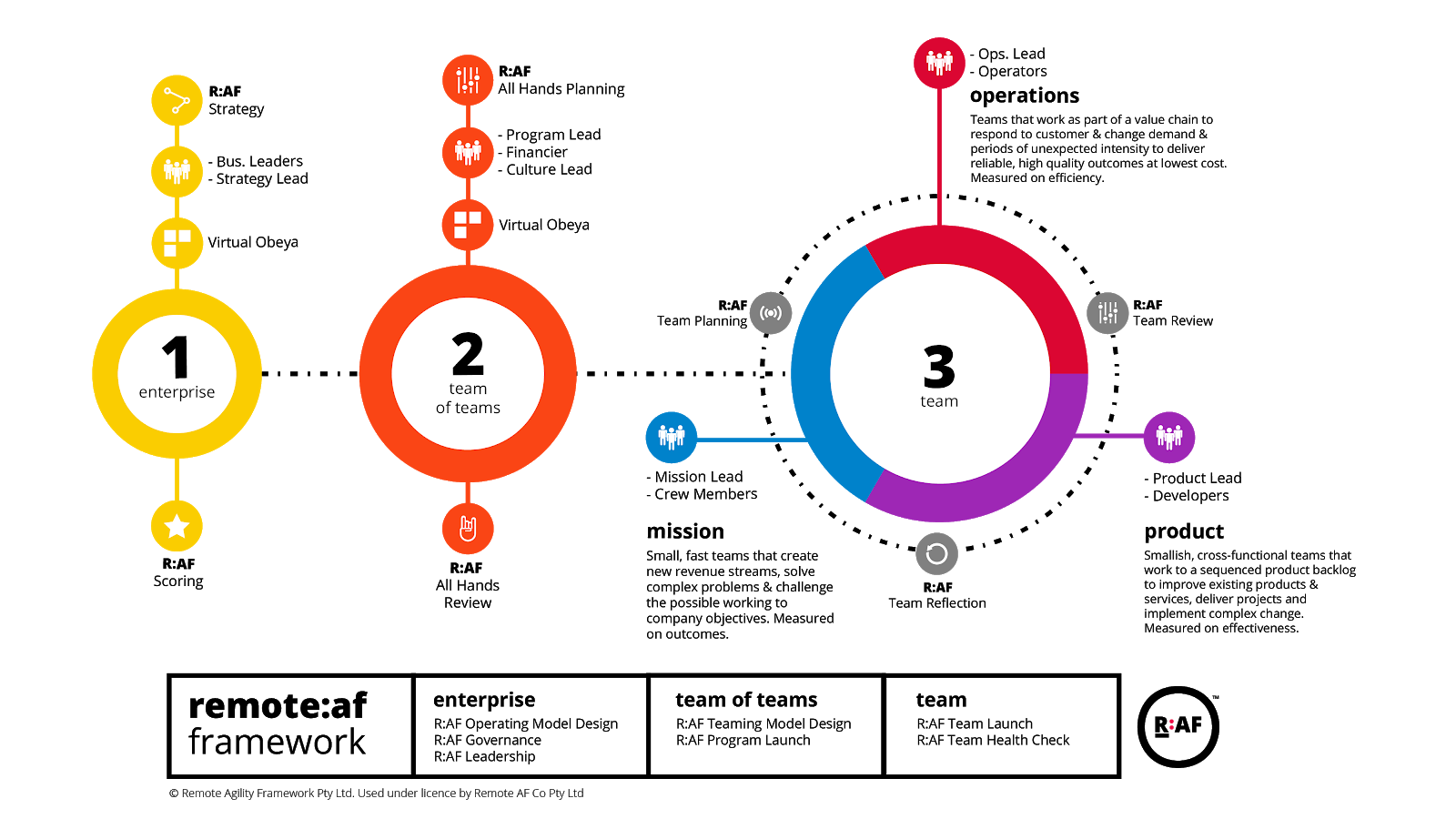2020 is not the year we expected. The COVID-19 pandemic has determined for many businesses how, when, and where their employees work. As we move into the second half of the year, the only certainty is that workforces need work-from-home capabilities.
Leaders who would never have considered flexible work arrangements 6 months ago, have put the processes and tools in place to allow for continued remote working. Yet, as organisations shift into a new financial year and new strategy, it begs the question: How do we execute on strategy in a distributed working environment?
Elabor8 recently ran a Leadership Webinar where Andrew Blain (Founder, Elabor8 & Remote:AF) provided a keynote, as well as an esteemed panel of Judith Barker (CEO, St John Ambulance NT), Phil Gadzinski (Global Digital Development CoE, Bupa), Peter Geers (Chief Strategy and Markets Officer, AEMO), and Teifi Whatley (Chief Strategy and Impact Officer, Sunsuper) looked to address this question.
What does COVID-19 mean for organisations?
Are we at a moment of great uncertainty and doubt, or unmatched opportunity? This is the question and challenge posed by keynote speaker Andrew Blain. COVID‑19 has acted as an incredible accelerator for new ideas and initiatives, which are moving across the ‘chasm’ between Early Adopters and the Early Majority (on the Change Adoption Curve) at a much faster rate. This acceleration has been driven by a massive shift in capital (intellectual, financial, people and commercial) creating new opportunities for fast moving organisations.
How do organisations take advantage of these opportunities? The answer undoubtedly is to double down on one of the most prevalent shifts, the change to remote and distributed working arrangements. There is a massive opportunity for organisations to effectively set themselves up for a ‘work from anywhere’ future.
For more than a decade Elabor8 has been helping some of Australia’s most complex companies adapt their business models for distributed agile teams. Our Remote Agility Framework (Remote:AF) is the culmination of our experience in how to develop highly effective remote workforces. The modular framework has three layers that can be applied independently or in unison: Enterprise, Team of Teams and Teams. At the Enterprise layer you need to establish clear intent with a strategy cycle that supports autonomous decision making with directional alignment. It’s key to establishing a sustainably short strategic cycle that is linked to the cadence of your delivery teams.

What have been the challenges and opportunities from the last 6 months?
In order to respond to the opportunities that Andrew Blain presented, the panel addressed how they have navigated the last 6 months of the pandemic in terms of the challenges and opportunities they’ve seen:
| Challenges | Opportunities |
|---|---|
| The need for some organisations to innovate their business models and funding approaches | Increased need for digital product and services |
| Existing governance approaches inhibit the fast decision making required through the crisis | Digital strategies are increasingly critical to business success and resilience |
| Responding to a shift in employee appetite to work from home | An ability to access new markets that were once limited by physical barriers |
| Organisations with operating models that enable remote working may have an advantage in attracting talent |
Phil Gadzinski from Bupa kicked off the panel discussion speaking about some of the challenges faced for a global organisation with a significant presence in countries hit hard by the pandemic like the UK and Spain. The increased customer need for digital products and services enabled an opportunity to change the conversation at the executive level around digital technology strategy to become more of a global business strategy. “It started as an initial response, and is now accelerating how we operate,” says Gadzinski.
Judith Barker of St John Ambulance NT added that at a strategic level, the response to the pandemic had enabled a catalyst for future opportunities in digital healthcare. A positive side effect of the move to remote working is that it has also effectively removed physical barriers to expand beyond our shores and engage with new markets.
Sunsuper’s Teifi Whatley spoke of the Government response of allowing members to withdraw superannuation early if needed which resulted in a large increase in member engagement. Whilst this provided challenges to the industry it also led to increased member engagement and opportunities for valuable feedback into customer touchpoints and ways of working. These inputs have provided an acceleration of Sunsuper’s digital strategy and improved engagement across digital channels with their members.
The pandemic has also required a much more dynamic approach to decision making. This has demonstrated that fast and effective decisions can be made and there is real opportunity to leverage and continue these efficiencies as organisations emerge on the other side of the crisis.
Peter Geers from AEMO spoke to the critical role that they play in the east and west coast energy markets to keep the electricity operating. AEMO has a well documented crisis management process which enables them to quickly respond. From an operational level this included restricting access to control rooms to ensure the risk of exposure to key staff is mitigated as much as possible.
The crisis also broke down many preconceived ideas around remote working across middle and senior management. They have heard from their staff that there is a real desire to partially work from home, which will present both challenges and opportunities around effectively empowering the workforce to do so. This has accelerated the need to consider collaboration approaches and operating models to support this emerging cultural change.
Handling the stresses and pressures while continuing to lead through a pandemic
The panel also spoke about the need to lead by example, and embody the behaviours that we want our people to exhibit.
Teifi Whatley spoke about setting work-from-home boundaries like closing the laptop, as well as continuing with personal development goals in spite of the crisis. Whatley emphasised that you need to, “put your own mask on first, and then help others.”
Judith Barker stressed that as leaders there is effectively no “switch-off point”, and outlined the role that having passion and purpose at work will play in safely getting through the current challenges. Furthermore, she highlighted the importance of surrounding yourself with passionate people that believe in the organisation’s goals and direction that can provide support through challenging times. Finally, Judith draws on her own optimistic outlook and recognises that while personal and professional goals may be delayed, she looks forward to being able to accomplish them in the future.
How are we looking after our people and the longer-term cultural impacts?
The panel collectively agreed that organisations have tried approaches to look after their people over the last 6 months and have learnt what has worked and what hasn’t.
Most panelists agreed that the initial reaction was to introduce more video meetings to stay connected and socialise, though this wore thin as we continued to operate in the pandemic. Now organisations are starting to get more creative.
Peter Geers from AEMO mentioned they introduced 2-3 hour windows during the day where their people weren’t expected to be online, so they could help their children with school work. Although it hasn’t worked perfectly as it has been tricky to co-ordinate at times, it proved to provide flexibility to their people and reduce the burden of trying to work and help their children at the same time.
Judith Barker from St John Ambulance NT spoke about ramping up wellness and support programs, which provided additional leave.
Organisations are looking to the longer-term cultural impacts of less physical connection, which includes re-designing offices to have more collaboration spaces instead of desks, and creating opportunities for people to network. One example is to create networking opportunities by running company Hackathons to both collaborate and develop innovative ideas.
From many ideas to executing strategy in a distributed working environment
As ideas continue to be generated at greater speed due to the acceleration the pandemic has caused, the panel then tackled how they are executing strategy in a distributed working environment.
Phil Gadzinski of Bupa spoke of their mature global, distributed and federated model, but still COVID added another level of complexity with everyone working from home. The 4 key focus areas for Bupa were:
- Clarity of what we do
- How we are communicating the strategy
- Designing our strategy in a collaborative way
- Executing on strategy through a community model
Strategy was co-designed with engagement and contribution from across the organisation at different levels and not just the traditional top down approach. Strategy execution at Bupa is built around a community model, also based on engagement and importantly who wants to be involved.
Across both strategy setting and execution Bupa has been using Remote:AF2 tools, adopting remote planning sessions, team launches, Obeya boards, strategy boards, governance boards, Big Room Planning – while running weekly sessions, monthly retrospectives, quarterly re-planning and has implemented global dashboard reporting to help support this. “We’re trying to run more of an Agile cadence across our strategy and execution,” says Gadzinski.
Peter of AEMO spoke of a sense across leadership and the Board of not knowing initially how to do strategy remotely; how to facilitate real conversations, brainstorming, etc. in a remote working environment. AEMO has collaboration tools but the culture was used to doing most things face-to-face, and Peter highlighted the difficulty for leadership teams in working out how to bring this all together. The initial reaction at AEMO was concern for losing visibility, a desire to lift monitoring of what’s going on, and an increasing top-down need for more reporting and more information.
AEMO adopted OKRs as a response to the pandemic2 to help sharpen the focus on outcomes, build employee engagement, and encourage trust top-down and bottom-up.
Teifi of Sunsuper then shared that their leadership were in the middle of planning Sunsuper’s 5 year strategy when COVID hit. The Board and Executive team were forced to take time out before re-engaging then re-affirming the clarity of their strategy, and also acknowledging that strategy execution would have to change. The process with the Board had been very different, all done remotely for the first time which forced them to think differently around how to better facilitate robust discussion. There was a need for a lot of pre-work.
Sunsuper has for the first time also adopted OKRs to roll out strategies across the organisation. OKRs have helped to execute on the divisional plans and to achieve alignment at all levels. There has also been a much greater emphasis placed on the first 1-2 years of the strategy, and a decision to accelerate agile ways of working across the enterprise.
It is time to take advantage of the opportunities
As highlighted, the pandemic has created opportunities for organisations to accelerate their strategies. While organisations are still coming to grips with their new or next normal, the challenges of executing on strategy will soon come to the forefront. Continuing to operate in the same ways as you did in the past will no longer work. However, taking advantage of new ways of working like the Remote Agility Framework1 to empower remote working, leveraging OKRs to articulate strategy down to execution2 for all teams, and leveraging remote Big Room Planning3 to plan large programs and highlight dependencies, are just a few approaches of how organisations are pivoting to effectively execute new strategies in a distributed working environment.
References:
- Remote:AF
- Using OKRs to increase business agility in a post coronavirus world
- How we pivoted to remote Big Room Planning on one week’s notice


